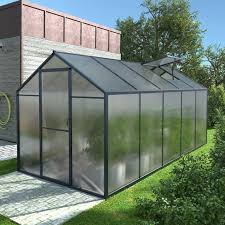The Benefits of Greenhouses for Sustainable Gardening
Greenhouses are invaluable structures for gardeners looking to extend their growing season, protect delicate plants from harsh weather conditions, and create a controlled environment for optimal plant growth. These enclosed spaces provide numerous benefits for sustainable gardening practices.
Year-Round Growing
With a greenhouse, gardeners can grow a wider variety of plants throughout the year by controlling temperature, humidity, and light levels. This allows for continuous harvests and the ability to grow crops that may not thrive in the local climate.
Protection from Pests and Diseases
Greenhouses act as a physical barrier against pests and diseases that can damage or destroy crops. By keeping plants enclosed, gardeners can reduce the need for chemical pesticides and promote natural pest control methods.
Water Conservation
By capturing and recycling water within a greenhouse, gardeners can minimize water waste and promote efficient irrigation practices. The controlled environment also helps prevent water evaporation, ensuring that plants receive adequate moisture.
Energy Efficiency
Modern greenhouses are designed with energy-efficient features such as insulated walls, double-glazed windows, and automated climate control systems. This helps reduce energy consumption for heating and cooling, making greenhouses more sustainable in the long run.
Sustainable Plant Propagation
Greenhouses provide an ideal environment for seed starting and plant propagation. By germinating seeds in a controlled setting, gardeners can increase germination rates, reduce transplant shock, and produce healthy seedlings for their gardens.
Soil Health Maintenance
With proper soil management practices within a greenhouse, gardeners can maintain soil health by reducing erosion, compaction, and nutrient depletion. Crop rotation and cover cropping techniques can be implemented to ensure long-term soil fertility.
Climate Change Adaptation
In the face of unpredictable weather patterns due to climate change, greenhouses offer a way to adapt to shifting growing conditions by providing a stable microclimate for plants to thrive in. This resilience is essential for sustainable food production in the future.
In conclusion, greenhouses play a vital role in sustainable gardening practices by offering year-round growing opportunities, pest protection, water conservation, energy efficiency, plant propagation support, soil health maintenance, and climate change adaptation strategies. Incorporating a greenhouse into your gardening efforts can enhance productivity while minimizing environmental impact.
Exploring the Essentials of Greenhouses: Purpose, Temperature Control, Concepts, and Cost Considerations
- What is the purpose of a green house?
- Do greenhouses stay hot in the winter?
- What is the concept of greenhouse?
- Is it cheaper to build or buy a greenhouse?
What is the purpose of a green house?
The primary purpose of a greenhouse is to create a controlled environment that enables gardeners to grow plants in optimal conditions. By harnessing sunlight and regulating temperature, humidity, and ventilation, greenhouses extend the growing season, protect plants from adverse weather, pests, and diseases, conserve water, promote energy efficiency, facilitate plant propagation, maintain soil health, and adapt to changing climate conditions. In essence, greenhouses serve as versatile tools for sustainable gardening practices by providing a sheltered space where plants can thrive year-round and where gardeners can cultivate a diverse range of crops with precision and care.
Do greenhouses stay hot in the winter?
Greenhouses can indeed stay warm in the winter, thanks to their design and the use of various heating methods. The glass or plastic walls of a greenhouse allow sunlight to enter and heat up the interior during the day. This trapped heat helps maintain a warmer temperature inside even when it’s cold outside. Additionally, some greenhouses are equipped with heating systems such as heaters, thermal mass materials, or insulation to regulate temperatures and keep plants cozy during colder months. Proper ventilation is also essential to prevent overheating and maintain a comfortable environment for plant growth year-round.
What is the concept of greenhouse?
The concept of a greenhouse revolves around creating a controlled environment for plants to thrive by harnessing the natural greenhouse effect. Greenhouses are structures typically made of transparent materials like glass or plastic that allow sunlight to enter and trap heat inside, creating a warm and humid microclimate ideal for plant growth. This controlled environment enables gardeners to extend the growing season, protect plants from harsh weather conditions, and optimize growing conditions for a variety of crops. By understanding the concept of a greenhouse and how it mimics the Earth’s natural processes, gardeners can harness this technology to cultivate healthy and bountiful gardens year-round.
Is it cheaper to build or buy a greenhouse?
When considering whether it is cheaper to build or buy a greenhouse, several factors come into play. Building a greenhouse from scratch allows for customization to suit specific needs and budget constraints. DIY construction can be cost-effective if utilizing recycled materials or opting for simpler designs. On the other hand, purchasing a pre-made greenhouse may offer convenience and quicker setup, but it can be more expensive upfront. Ultimately, the cost-effectiveness of building versus buying a greenhouse depends on individual preferences, resources, and long-term gardening goals.

